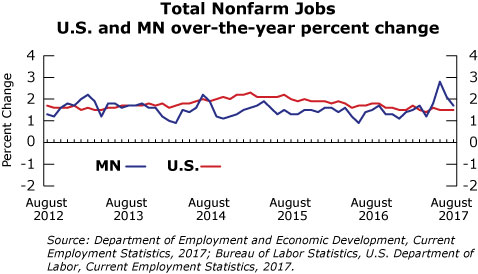by Nick Dobbins
September 2017
Monthly analysis is based on unadjusted employment data.
Employment in the Minneapolis-St Paul MSA was down very slightly in August, off by 855 (0.0 percent) from July’s estimate. It marked the first August employment decline in the metro since 2009. The drop was driven in large part by Leisure and Hospitality which shed 2,970 jobs (1.5 percent) following disproportionately large gains in May and June, roughly the same movement the state as a whole showed. The largest monthly job growth in the metro, both proportionally and in total jobs, came in Professional and Business Services (up 2,654 jobs or 0.8 percent). A large increase in Employment Services jobs (up 2,578 or 5 percent) accounted for most of the growth, after employment there had declined by 2.9 percent in July. Annually metro area employment was up by 44,846 (2.3 percent). Growth remained nearly universal among supersectors, with the lone negative growth coming in Information, which was off by 771 jobs (2 percent). Educational and Health Services remained the leading source of employment growth, adding 16,504 jobs (5.1 percent) with Health Care and Social Assistance accounting for most of that (up 15,732 or 5.6 percent). Professional and Business Services, with its strong August performance, moved up to a 2.8 percent over-the-year change (9,162 jobs). Goods producers showed broadly strong annual growth, with Manufacturing adding 4,746 jobs (2.4 percent) and Mining, Logging, and Construction adding 3,500 (4.1 percent).
The Duluth-Superior MSA lost 141 jobs (0.1 percent) in August with supersectors split evenly between negative and positive monthly job growth. Notable over-the-month growth occurred in Trade, Transportation, and Utilities (up 317 or 1.3 percent) and Mining, Logging, and Construction (up 138, 1.3 percent) while employment in Professional and Business Services was down 176 (2.1 percent). As was the case across Minnesota, Leisure and Hospitality also saw a steep monthly drop, off by 208 (1.3 percent). Over the year Duluth added 3,030 jobs (2.2 percent). Mining, Logging, and Construction continued to lead the way in annual change, up 10.7 percent or 1,066 jobs. Educational and Health Services chipped in 1,071 jobs, an over-the-year change of 3.5 percent. The largest actual job loss came in Professional and Business Services, which shed 99 jobs (1.2 percent).
Employment in the Rochester MSA was down by 277 (0.2 percent) in August. The most notable declines came in Educational and Health Services (off by 347 jobs or 0.7 percent), Trade, Transportation, and Utilities (down 140, 0.8 percent) and Leisure and Hospitality (down 41 or 0.4 percent). Notable gains were in Government (up 151 or 1.2 percent) and Mining, Logging, and Construction (72 or 1.4 percent). Annually Rochester added 1,444 jobs (1.2 percent). Mining, Logging, and Construction added 319 jobs (6.5 percent), Professional and Business Services added 301 (5.4 percent), and Educational and Health Services added 542 (1.1 percent). The most notable decline was in Trade, Transportation, and Utilities, which shed 106 jobs (0.6 percent).
Employment in the St. Cloud MSA was up in August as the area grew by 559 jobs (0.5 percent), while the state as a whole lost jobs. Leisure and Hospitality went in a dramatically opposite direction from the rest of the state, adding 286 jobs (3.2 percent), perhaps in part because the supersector did not see the same gains as the rest of the state earlier in the summer. The largest decline occurred in Trade, Transportation, and Utilities, which was off by 169 (0.7 percent) caused in part by the loss of 114 jobs (0.8 percent) in Retail Trade. Annually St. Cloud added 1,752 jobs (1.6 percent). The largest increases came in Educational and Health Services (up 1,166 or 5.6 percent) and Mining, Logging, and Construction (up 841 or 11.6 percent).
The Mankato-North Mankato MSA added 558 jobs (1 percent) in August. That was the fastest proportional over-the-year growth of any MSA in Minnesota. All of the growth came from service providers (up 604 or 1.4 percent) as goods producers lost 46 jobs (0.4 percent). Among service providers, Government employers led the way with 583 new jobs, an increase of 7.2 percent over August of 2016. Annually the Mankato area added 1,111 jobs (2 percent). Every published component added employment, with goods producers adding 290 jobs (2.9 percent) and service providers adding 821 (1.8 percent).
The Fargo-Moorhead MSA added 1,067 jobs (0.8 percent) in August. The largest increase, both proportionally and in actual jobs, was in Trade, Transportation, and Utilities, which added 451 jobs (1.5 percent) on the back of growth of 426 (2.8 percent) in Retail Trade. Annually Fargo-Moorhead added 3,143 jobs (2.3 percent). The only supersector with negative growth on the year was Information, off by 142 (4.3 percent).
The Grand Forks-East Grand Forks MSA added 144 jobs (0.3 percent) in August. No supersector saw movement of more than 100 jobs in either direction. The most dramatic proportional change came in the Financial Activities supersector, which added 43 jobs (2.4 percent). Annually the Grand Forks-East Grand Forks MSA lost 726 jobs (1.3 percent). It remained the only MSA in the state to lose jobs over the year. Once again the steepest employment decline, by a large margin, came in Mining, Logging, and Construction which was down by 1,162 (23.6 percent).
